Written by Tom Grow
Mahalo to Brenda Stokes for contacting Tom Grow and making this timeline available.

Early shot of a surfer at Pensacola Beach in 1941 Many Navy servicemen from the West Coast (California) brought their boards to Florida. Photographer unknown, photo provided by Tom Hutson.
1941: Navy servicemen from California bring their surfboards to Florida with them during war time.
Modern Surfing Begins
1957: A Navy guy comes to the beach with his surfboard and surfs while the Pensacola Beach lifeguards watch. Danny Stone, one of the lifeguards, talks with him and is given a “lesson” surfing. The Navy surfer was Jim Meyring.
1958: Dale Butt and Roddy Mead (also lifeguards) decide to make a board for themselves. They get blocks of Styrofoam, glue them together, shape a crude board, and attempt to glass it with polyester resin. Realizing this won’t work, they coat the board with rubber-based paint and then glass the board with cloth and resin (Glass job doesn’t stick to foam. A picture of the board is featured with Tom Grow). They begin surfing at the beach.
1959: Five of the lifeguards decide to order new Hobie boards. Dale Butt teaches Tom Grow how to surf. Scott Bush learns to surf in California.

Dale Butt gives Tom Grow (pictured) the first board shaped on the Gulf Coast, 1960.
1960: Scott Bush moves to Pensacola. Dale Butt gives Tom Grow the first board made on the Gulf Coast.
1961: Tom, Scott, and the lifeguards continue to surf. A few others join the group.
1962: Tom Grow orders new Hobie. Tom Grow and Scott Bush go to California to spend a month in San Diego with Dale Butt who has moved to Ocean Beach to surf. They continue to surf in Pensacola.
1963: Tom Grow returns to California and hangs out at Small and Nieves (S&N Boards) surf shop. While Tom is in California, Benny Jackson contacts Scott and tells him Jack Waters (owner of Hutson Hardware) wants to make surfboards to sell. Scott and Tom confer on the phone and decide to tell Jack they know how to make boards (not quite true) and that they will set up the shop. Tom returns from California and that Fall, they began to make boards.
At the Hutson factory, Scott Bush was the shaper, Tom Grow was the glasser, and Benny Jackson worked on fins and sanded.
1964: Tom and Scott continue at Hutson making boards. The Islander brand was created to use on the pop-out boards they began to make. The Islander brand was later used on custom boards made by Brian Waters- the son of Jack Waters- who owned Hutson’s. The Hutson brand was used for the custom boards.

World Surfing Contest 1965
1965: Scott and Tom continue to work at Hutson’s. Tom Grow competes in the World Contest in Peru.
1965: Scott continues at Hutson’s and goes to shape at the Dayton Beach Surf Shop in the fall. Tom Grow and John Russell go to San Diego to surf. John returns to Pensacola, Tom stays in San Diego.
1966: Scott continues to shape at Daytona Beach, Tom Grow returns from California to become the glasser at Dayton Beach.
1967: Scott and Tom both move to San Diego where they work regular jobs and also shape and glass for Challenger Surfboards. In late 1967, both return to Pensacola.
1968: Scott open the first surf shop in Pensacola selling Challenger Surfboards. Tom and Scott start Design Line Surfboards. Scott starts a surf team with Yancy Spencer, John Spencer, and Beaser Turner.

The Challenger Surf Shop Team poses with their Design Line surfboards. Pictured from right to left are: Yancy Spencer, John Spencer, and Beaser Turner
The short board revolution takes place at this time. Scott opens a larger shop in Gulf Breeze, Florida.
Scott competes and wins at Florida State Championships in Daytona Beach.
1969: Yancy Spencer opened a shop in the location of Scott’s first shop. Scott moves to a new location in Pensacola and opened the “Pants Tree” selling surfboards and clothing. Tom Grow goes to the University of West Florida and begins working at the Environmental Protection Lab at Pensacola Beach.
1970- 1984: Tom Grow attends the University of Florida in Gainesville to get his PhD and begins teaching at UF. Scott begins working at NADEP (Naval Aviation Depot) in Pensacola.
1984: Tom Grow returns to Pensacola and he and Scott take a surf trip to Hawaii. Upon returning from Hawaii, Tom and Scott begin building surfboards again as well as windsurfers.
1988: Tom begins teaching at Pensacola Junior College while still surfing.
1994: Scott moves to Jacksonville to work and begins shaping for Straight Up Surfboards (Greg Stritch).
2002 – 2013: Scott returns to Pensacola and does occasional shaping for Steve and Tom Stack.
2016 and beyond: Tom and Scott still surfing….
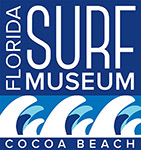


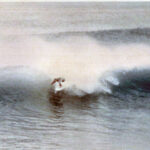
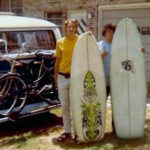
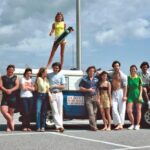

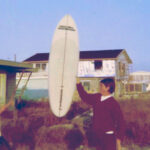


Thank you for having this info available. I was remembering going to Pensacola Beach with my grandparents in 1959 (I was 5) and seeing people surfing on the other side of the pier and wanting to do that! And I questioned whether my memory was correct because I wasn’t sure surfing had come to Pensacola that early. Now I see that it had, and I remember correctly. Eventually, I learned to surf in Jacksonville, moved back to Pensacola and bought my first board at Hutson’s – a 9’4” Joyce Hoffman model Hobie. In 1969 I bought a 6’10” Challenger at Scott’s surf shop. In 1970 Scott asked me to surf for Challenger and I became the only female on the team, but I definitely wasn’t the same caliber as Yancey and Beaser. Later Brian Waters shaped 2 Islanders for me, a 6’8 similar to my Challenger and a 7’ egg. I still have both boards, but boogie board now because I rarely get to surf living in Tallahassee. If I’m at the beach and there’s waves, I’ll be out there even if I’m just body surfing!
Hello Lee- Sorry for the late reply but we have had issues with our webpage. Thanks for the great story. If you have any pictures to share we would love to see them. We are helping curate a surfing exhibit at the Florida History museum in Tallahassee. It should be up some time in November. Stay tuned!
Does anyone one know who was shaping for Islander Surfboards around 1979-80 ?
I believe I had a custome board made through innerlight and it had the Islander brand on it.
A few of us were experimental not with concaves and channels on our boards. They made me a Mark Richards dual fin style with dual concaves. The shaper said he had to use two blanks to ge5 it right, but it was a sweet board. I hadn’t ridden it for more than twenty years and a few years back I thought for fun I’d go ride it one day.
Now mind you in the late 70’s most boards were heavy glass, but other than the weight it was unreal laying down on it and paddling. It fit like a glove still, nothing like any newer board I own. Shapers back then made a board for you, he asked height weight, how I surfed, what I was expecting.
I was stationed there from 78-81, and had a great time at the beaches there.
Sorry for the reminiscing but just wondering if that same shaper is still around, or any of the regulars from that time period actually
Surf safe all
Hello Butch- our facebook page often has posts from Tom Hutson of Pensacola. He has numerous photos from the the panhandle with stories of surfing back then including comments about Islander Surfboards.